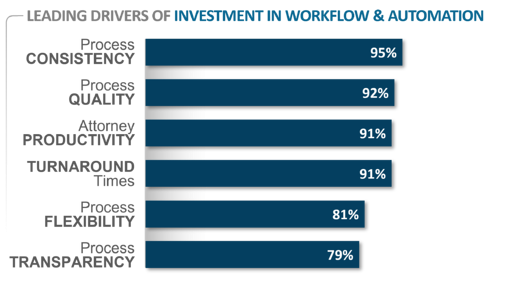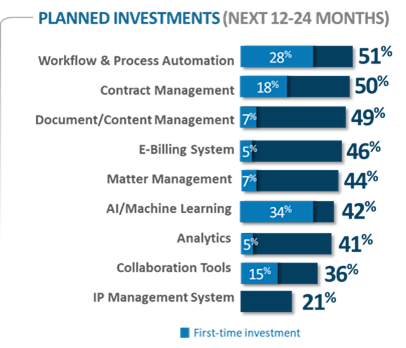As companies tackle digital transformation, many focus on investing in the newest, most sophisticated legal technology, which is not the best approach to buying software solutions. Sequencing tech purchases is important, building capabilities with each – rather than taking on expensive, overwhelming software. To create a future-proof legal technology roadmap, it’s critical to first identify the specific people, practice areas, and processes within the legal department that would benefit most from digital transformation and begin the roadmap process with the end in mind.
Confer with your legal team to understand exactly where your process and operational challenges exist. For example, consider whether inefficiencies are being created by poor allocation of work, a lack of cross-functional collaboration, or disparate systems the team is using. Only then can you properly evaluate competing technologies and begin the journey toward optimized legal operations.
To select tech solutions, companies generate RFPs that define requirements against which offerings are compared. Often, these cross-functional vendor evaluations expose competing priorities between departments. Taking time up front, before issuing the RFP, to understand the needs and intent of colleagues in various parts of the business will drive precise alignment around the priorities for any technology purchase and ensure that the result is future-proof.
WORKFLOW AND AUTOMATION ARE KEY PRIORITIES
Sophisticated legal departments are constantly looking for ways to improve consistency, quality, productivity, velocity, flexibility, and transparency. And what lawyer wouldn’t want all those attributes? It’s about improving the daily working life of corporate legal staff – making their jobs more rewarding while also better serving the corporation. This is why, when Hyperion Research surveyed over 200 corporate legal departments, we saw a strong focus and investment in workflow and process automation, along with system integrations and the flow of information, to improve the experience - which in turn accelerates adoption.

Recent Hyperion Research market studies found that the top technology category in which Legal Operations Managers plan to invest in the next 12-24 months is workflow and automation, followed closely by contract management systems, which of course are fundamentally workflow-driven systems.

Why? Because every legal department wants to reduce the friction that comes from working in and supporting an average of eight or more legal practice applications. More important, workflow systems that route the right work to the right person, gathering key information and assembling documents along the way, enable in-house lawyers to focus where they should – on nuanced legal issues rather than administrative processes.
ROADMAPS THAT LEAD TO IMPROVED PERFORMANCE
When creating a legal technology roadmap, it’s important to focus on generating momentum – and data to inform continuous improvement. Some tips:
- Before crossing the starting line, capture baseline KPIs such as cycle times, person hours, and costs – even if the metrics are rough and gathered manually.
- Establish a starting point you can show improvement against.
- Make sure each new system you implement generates usable data to show improvement in key performance metrics.
- When evaluating technology options, don’t neglect data categorizations and reporting for performance management.
- Address key pain points first to build acceptance of new ways of working, build momentum and advocacy, and perhaps generate savings to fuel additional investments.
- The "low hanging fruit" are low cost/effort capabilities with impact on day-to-day activities.
- In later stages, integration across systems will be key, so build with those capabilities in mind.
- Actionable information flows across systems and stakeholders.
- Note that integrations will take several forms – across applications in Legal and with enterprise business applications, and with data from multiple sources (you may need a tool for that too).
- As data begins to accumulate, it can be tempting to get carried away – be sure to focus on actionable metrics. Are we generating savings? Reducing risk? Cutting cycle times? And importantly, what insights can we glean from the data to directly drive performance?
Don't underestimate the importance of change management.
We’re seeing formalized adoption processes become more sophisticated, and clear cross-functional change management plans are the heartbeat of sustaining any legal transformation program. Hyperion benchmarking has found that the key to widespread technology adoption is usability and approachability. Legal staff are now working in more dynamic and mobile environments, and they want a uniform experience across all platforms, along with real-time access to actionable information to support decision-making wherever and whenever it needs to occur. When the technology does not meet those fundamental needs, we see adoption rates plummet and investments squandered.
Begin with the end in mind.
Think about sequence, pace and the user experience to maximize adoption. Visualize a state in which you have the reporting you need to pinpoint trouble spots, such as chronic negotiation breakdowns, approval hang-ups, or non-compliance with policies and procedures. Then you will have not only the interconnected tools, but also the necessary information to adjust, flow faster and provide better legal services, ensuring a happy, high-functioning legal team.
Published June 24, 2022.




